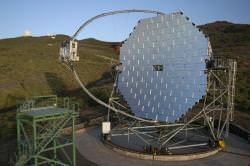Written by Fraser Cain

The speed of light is the speed of light, and that's that. Right? Well, maybe not. Try and figure this out. Astronomers studying radiation coming from a distant galaxy found that the high energy gamma rays arrived a few minutes after the lower-energy photons, even though they were emitted at the same time. If true, this result would overturn Einstein's theory of relativity, which says that all photons should move at the speed of light. Uh oh Einstein.
The discovery was made using the new MAGIC (Major Atmospheric Gamma-ray Imaging Cherenkov) telescope, located on a mountain top on the Canary island of La Palma. Since gamma rays are blocked by the Earth's atmosphere, astronomers have figured out a clever trick to see them from the ground. When the gamma rays strike the atmosphere, they release a cascade of particles and radiation. The Cherenkov technique detects this cascade, and then works backwards to calculate the direction and energy level of the gamma rays. With a 17-metre detector, MAGIC is the largest telescope of its type.
The international team of researchers pointed the telescope at Markarian 501, a galaxy 500 million light-years away that contains a blazar - a supermassive black hole that periodically releases bursts of gamma rays. More material is falling into the black hole than it can consume, and so it gets squeezed into jets that fire off from the poles of the black hole at close to the speed of light. What astronomers call a "blazar" is when the jets of a supermassive black hole are pointed directly at the Earth.
Researchers sorted high- and low-energy gamma ray photons coming from the blazar with each flareup. Since all the radiation was emitted at the same time, and the speed of light is the speed of light, you would expect the high-energy photons to arrive at the same time. But nope, the high-energy photons showed up around 4 minutes later.
So what's happening? Nobody knows, and this could turn into an entirely new field of physics. The researchers are proposing that maybe the radiation is interacting with "quantum foam". This is a theoretical property of space itself, and predicted by quantum gravity theory - a competitor to string theory.
Original Source: UC Davis News Release



No comments:
Post a Comment